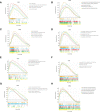Colorectal Cancer Chemotherapy Drug Bevacizumab May Induce Muscle Atrophy Through CDKN1A and TIMP4
- PMID: 35847900
- PMCID: PMC9283830
- DOI: 10.3389/fonc.2022.897495
Colorectal Cancer Chemotherapy Drug Bevacizumab May Induce Muscle Atrophy Through CDKN1A and TIMP4
Abstract
The muscle in the organism has the function of regulating metabolism. Long-term muscle inactivity or the occurrence of chronic inflammatory diseases are easy to induce muscle atrophy. Bevacizumab is an antiangiogenic drug that prevents the formation of neovascularization by inhibiting the activation of VEGF signaling pathway. It is used in the first-line treatment of many cancers in clinic. Studies have shown that the use of bevacizumab in the treatment of tumors can cause muscle mass loss and may induce muscle atrophy. Based on bioinformatics analysis, this study sought the relationship and influence mechanism between bevacizumab and muscle atrophy. The differences of gene and sample expression between bevacizumab treated group and control group were studied by RNA sequencing. WGCNA is used to find gene modules related to bevacizumab administration and explore biological functions through metascape. Differential analysis was used to analyze the difference of gene expression between the administration group and the control group in different muscle tissues. The key genes timp4 and CDKN1A were obtained through Venn diagram, and then GSEA was used to explore their biological functions in RNA sequencing data and geo chip data. This study studied the role of bevacizumab in muscle through the above methods, preliminarily determined that timp4 and CDKN1A may be related to muscle atrophy, and further explored their functional mechanism in bevacizumab myotoxicity.
Keywords: CDKN1A; TIMP4; bevacizumab; muscles; sarcopenia.
Copyright © 2022 Xu, Li, Wu, Zhou and Xu.
Conflict of interest statement
The authors declare that the research was conducted in the absence of any commercial or financial relationships that could be construed as a potential conflict of interest.
Figures






Similar articles
-
CUL3 and COPS5 Related to the Ubiquitin-Proteasome Pathway Are Potential Genes for Muscle Atrophy in Mice.Evid Based Complement Alternat Med. 2022 Jun 30;2022:1488905. doi: 10.1155/2022/1488905. eCollection 2022. Evid Based Complement Alternat Med. 2022. PMID: 35815279 Free PMC article.
-
Circulating vascular endothelial growth factor receptor 2/pAkt-positive cells as a functional pharmacodynamic marker in metastatic colorectal cancers treated with antiangiogenic agent.Invest New Drugs. 2013 Feb;31(1):1-13. doi: 10.1007/s10637-012-9817-7. Epub 2012 Apr 27. Invest New Drugs. 2013. PMID: 22539090
-
(99)mTc-(CO)(3) His-annexin A5 micro-SPECT demonstrates increased cell death by irinotecan during the vascular normalization window caused by bevacizumab.J Nucl Med. 2011 Nov;52(11):1786-94. doi: 10.2967/jnumed.111.092650. J Nucl Med. 2011. PMID: 22045708
-
Integration of novel agents in the treatment of colorectal cancer.Cancer Chemother Pharmacol. 2004 Sep;54 Suppl 1:S32-9. doi: 10.1007/s00280-004-0884-0. Cancer Chemother Pharmacol. 2004. PMID: 15309512 Review.
-
Bevacizumab in combination chemotherapy for colorectal and other cancers.Am J Health Syst Pharm. 2005 May 15;62(10):1021-32. doi: 10.1093/ajhp/62.10.1021. Am J Health Syst Pharm. 2005. PMID: 15901587 Review.
Cited by
-
Exploring molecular mechanisms underlying the pathophysiological association between knee osteoarthritis and sarcopenia.Osteoporos Sarcopenia. 2023 Sep;9(3):99-111. doi: 10.1016/j.afos.2023.08.005. Epub 2023 Sep 15. Osteoporos Sarcopenia. 2023. PMID: 37941536 Free PMC article.
-
The application of QCT in the prognostic assessment of mCRC undergoing first-line treatment based on bevacizumab.Future Oncol. 2024 Dec;20(40):3433-3442. doi: 10.1080/14796694.2024.2430160. Epub 2024 Nov 18. Future Oncol. 2024. PMID: 39558658 Free PMC article.
-
Exploring the link between the ZJU index and sarcopenia in adults aged 20-59 using NHANES and machine learning.Sci Rep. 2025 Jul 2;15(1):22650. doi: 10.1038/s41598-025-01124-w. Sci Rep. 2025. PMID: 40593830 Free PMC article.
-
Pregnancy after advanced ovarian cancer with spontaneous uterine rupture in second trimester: A case report and review of the literature.Int J Gynaecol Obstet. 2025 Jan;168(1):57-62. doi: 10.1002/ijgo.15837. Epub 2024 Aug 1. Int J Gynaecol Obstet. 2025. PMID: 39087457 Free PMC article. Review.
References
LinkOut - more resources
Full Text Sources

